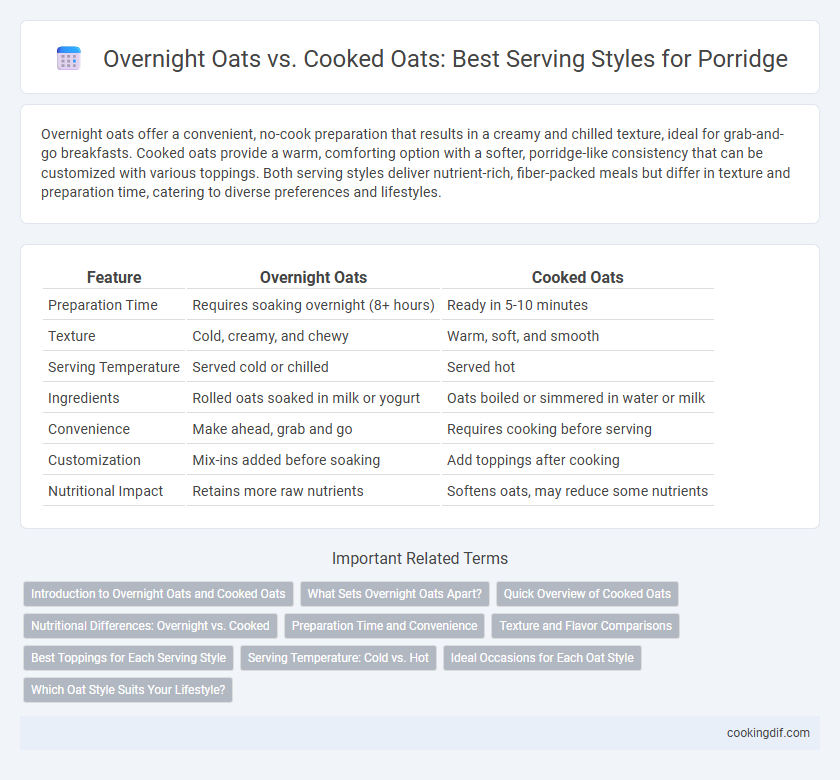Overnight oats offer a convenient, no-cook preparation that results in a creamy and chilled texture, ideal for grab-and-go breakfasts. Cooked oats provide a warm, comforting option with a softer, porridge-like consistency that can be customized with various toppings. Both serving styles deliver nutrient-rich, fiber-packed meals but differ in texture and preparation time, catering to diverse preferences and lifestyles.
Table of Comparison
| Feature | Overnight Oats | Cooked Oats |
|---|---|---|
| Preparation Time | Requires soaking overnight (8+ hours) | Ready in 5-10 minutes |
| Texture | Cold, creamy, and chewy | Warm, soft, and smooth |
| Serving Temperature | Served cold or chilled | Served hot |
| Ingredients | Rolled oats soaked in milk or yogurt | Oats boiled or simmered in water or milk |
| Convenience | Make ahead, grab and go | Requires cooking before serving |
| Customization | Mix-ins added before soaking | Add toppings after cooking |
| Nutritional Impact | Retains more raw nutrients | Softens oats, may reduce some nutrients |
Introduction to Overnight Oats and Cooked Oats
Overnight oats consist of rolled oats soaked in liquid, such as milk or yogurt, and left to absorb flavors and soften without heat, resulting in a creamy, ready-to-eat breakfast. Cooked oats, typically made from steel-cut, rolled, or instant oats, are boiled or simmered to achieve a warm, thick porridge texture that varies with cooking time and oat type. Both serving styles offer distinct textures and preparation methods to suit different taste preferences and time constraints.
What Sets Overnight Oats Apart?
Overnight oats are prepared by soaking raw oats in liquid, such as milk or yogurt, allowing them to absorb moisture and soften naturally without heat. This no-cook method retains more nutrients like resistant starch and offers a creamy texture that differs from the traditional cooked oats served warm. The convenience of making overnight oats ahead enhances their appeal for quick, nutrient-rich breakfasts with customizable toppings.
Quick Overview of Cooked Oats
Cooked oats offer a warm, creamy texture achieved by boiling oats with water or milk, ideal for a comforting breakfast. They can be prepared using rolled oats, steel-cut oats, or instant oats, each varying in cooking time and consistency. Cooked oats provide a versatile base for toppings like fruits, nuts, and sweeteners, making them suitable for customizable and satisfying porridge servings.
Nutritional Differences: Overnight vs. Cooked
Overnight oats retain more heat-sensitive nutrients like vitamin C due to the absence of cooking, while cooked oats offer higher bioavailability of minerals such as iron and zinc through the breakdown of phytates. The soaking process in overnight oats increases soluble fiber content, promoting better digestion and sustained energy release, whereas cooking enhances starch gelatinization, improving carbohydrate digestibility. Choosing between overnight and cooked oats depends on prioritizing nutrient preservation versus enhanced mineral absorption for tailored nutritional benefits.
Preparation Time and Convenience
Overnight oats require minimal preparation time, as they are soaked in liquid overnight, allowing for a quick, ready-to-eat breakfast without any cooking. Cooked oats need active cooking, typically 5-10 minutes on the stove or microwave, which takes longer but provides a warm, freshly cooked texture. For convenience, overnight oats excel with their grab-and-go style, while cooked oats offer immediate warmth but require more effort and time to prepare.
Texture and Flavor Comparisons
Overnight oats offer a creamy and smooth texture with a subtle, naturally sweet flavor due to prolonged soaking in liquid, while cooked oats provide a warm, hearty consistency with a richer, more robust taste from the cooking process. The cold, soft texture of overnight oats makes them ideal for quick, grab-and-go breakfasts, whereas cooked oats deliver a comforting, thicker mouthfeel perfect for leisurely meals. Flavor absorption differs as overnight oats retain the distinct taste of added ingredients like fruits or spices, while cooked oats develop deeper caramelized notes during boiling.
Best Toppings for Each Serving Style
Overnight oats pair perfectly with fresh fruits like berries, sliced bananas, and crunchy nuts, enhancing their creamy texture without additional heat. Cooked oats benefit from warm toppings such as cinnamon, stewed apples, and melted nut butter to complement their soft, hearty consistency. Both styles are delicious when garnished with chia seeds or a drizzle of honey for extra flavor and nutrition.
Serving Temperature: Cold vs. Hot
Overnight oats are typically served cold, offering a refreshing and convenient option that retains a creamy texture due to soaking in milk or yogurt. Cooked oats, on the other hand, are served hot, providing a warm, comforting meal with a softer consistency achieved through boiling or simmering. Choosing between overnight oats and cooked oats depends largely on preference for serving temperature and desired texture in porridge.
Ideal Occasions for Each Oat Style
Overnight oats offer a convenient, no-cook option perfect for busy mornings or grab-and-go breakfasts, making them ideal for workdays or quick meal prep. Cooked oats provide a warm, comforting meal suited for colder seasons or leisurely weekend breakfasts when time allows for a soothing, hearty serving. Each style caters to different lifestyle needs, with overnight oats emphasizing convenience and cooked oats focusing on warmth and texture.
Which Oat Style Suits Your Lifestyle?
Overnight oats provide a convenient, no-cook option perfect for busy mornings and on-the-go lifestyles, requiring minimal preparation and refrigeration overnight. Cooked oats offer a warm, comforting meal ideal for slower mornings or colder days, allowing customization with various toppings and flavors during cooking. Choosing between them depends on whether you prioritize quick, ready-to-eat meals or prefer the versatility and warmth of freshly prepared porridge.
Overnight oats vs Cooked oats for serving style Infographic

 cookingdif.com
cookingdif.com